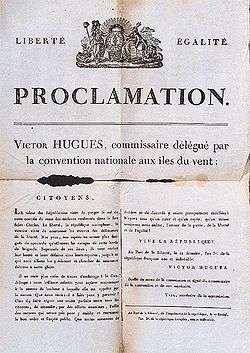Victor Hugues
Victor Hugues (born in Marseille July 20, 1762[1] and died in Cayenne August 12, 1826[2]) was a French politician and colonial administrator during the French Revolution, who governed Guadeloupe from 1794 to 1798, emancipating the island's slaves under orders from the National Convention.
Early life and appointment
Jean Baptiste Victor Hugues was born to a rich family of Marseille's bourgeoisie, son of Jean-François Hugues 1725-1789, a salesman, and Catherine Fodrin 1729-1822, issued from a family of silk traders of Saint-Étienne.
The family settled as colonists in Saint-Domingue at the beginning of the 1780s, but Victor was forced to return to France because of the Haitian Revolution. He then appointed Procureur of the Comité de salut public in La Rochelle with the support of the local Jacobin Club. He was subsequently appointed governor of Guadeloupe, where he was ordered to apply the emancipation decrees which declared the end of slavery in all French territories in February 1794.
Conflicts with Great Britain and the United States
Following the signing of the Whitehall Accord by (representing Guadeloupe), a British task force successfully invaded the island in April 1794. The planters and other Royalists had signed the Whitehall Accord with the British and colluded with France's rival as a way of rejecting revolutionary events, particularly the abolition of slavery. When Hugues disembarked on 21 May 1794, he had a small force of 1,150 soldiers. He immediately declared an end to slavery and so rallied the slaves and gens de couleur. Within five days he took the capital, Pointe-à-Pitre. Hugues was able to retake the island by 6 October 1794, when he obliged the English general to surrender in his camp of Barville with his whole force, in which were comprised 800 French emigres and 900 soldiers of African descent. He led a failed attempt to retake Anguilla in 1796.[3]

Even though he abolished chattel slavery, he still maintained a system of unpaid obligatory work. He reorganised the army, recruiting a large number of African former slaves, until his armed force amounted to around 10,000 men. Soldiers of both African and European descent were integrated into the same units with no racial distinctions.
He ruled for four years before being recalled to France and was replaced by General Edme Desfourneaux. During that time, he purged the island of counter-revolutionaries, using a guillotine brought from France, and also worked to create a viable post-slavery regime, in which the island's farms and plantations still functioned.
Hugues is perhaps best known for authorizing privateers to attack shipping through the Caribbean, which brought great wealth to the island but also was part of the tensions between France and the United States (known as the Quasi-War in American history).
With an army composed of White, Mulatto and ex-slave soldiers, Hugues worked to export the revolution to neighboring islands, including Dominica, Saint-Martin, Grenada, Saint Vincent and Saint Lucia. On 18th April 1795 he landed in Saint Lucia with 600 soldiers. They joined the 250 local Republicans and 300 Blacks, most of them carrying spikes but some with rifles captured from the British. The British from Castries landed over a thousand troops at Vieux Fort and marched them overland to Soufriere. They attacked on April 22nd at Fond Doux and Rabot. However, after heavy fighting the English were forced to withdraw back to Castries. They were eventually defeated on June 19th, and fled from the island. The Royalist planters fled with them, leaving the remaining Saint Lucians to enjoy “l’Année de la Liberté”, “a year of freedom from slavery…” [4]
Guiana
In 1799, Hugues was envoyed to French Guiana by the French Consulate, where he was responsible for legislating unfree labour, and then slavery itself. He remained an administrator under the early years First Empire, but was forced out when an Anglo-Portuguese force under the command of Captain Yeo of HMS Confiance invaded the colony and captured it on 14 January 1809.
Upon his return, he was prosecuted for treason and conspiracy with the enemy. Acquitted in 1814, he returned to Guiana in 1817, served as governor and then stayed on as a private citizen.
Cuban writer Alejo Carpentier made Hugues protagonist of his acclaimed novel "El Siglo de las Luces" (Explosion in a Cathedral), published in 1962.
American author, James A. Michener, includes an accounting of Hugues time spent on the Island of Guadeloupe in his work of historical fiction; "The Caribbean". In the chapter entitled 'The Creoles', Michener includes both historical facts about the man, and adds him to several fictional situations and plot twists. "The Caribbean" was published in 1989.
References
- ↑ Archives départementales des Bouches-du-Rhône, On line Marseille city records, St-Martin parish, picture 128, baptism of July 21, 1762.
- ↑ CAOM, On line records, Cayenne death tables classified with 1825 year, picture 37.
- ↑ Martin, Robert Montgomery (1839), "Chapter XIV.—Anguilla.", Statistics of the Colonies of the British Empire in the West Indies, South America, North America, Asia, Austral-Asia, Africa, and Europe; comprising the Area, Agriculture, Commerce, Manufactures, Shipping, Custom Duties, Population, Education, Religion, Crime, Government, Finances, Laws, Military Defence, Cultivated and Waste Lands, Emigration, Rates of Wages, Prices of Provisions, Banks, Coins, Staple Products, Stock, Moveable and Immoveable Property, Public Companies, &c. of Each Colony; with the Charters and the Engraved Seals. From the Official Records of the Colonial Office., London: William H. Allen & Co., p. 102.
- ↑ http://soufrierefoundation.org/about-soufriere/history
External links
- Hugues, Victor. "Guyane française. Code civil. Avec modifications, ordonnance coloniale du 1er Vendémiaire an XIV (23 septembre 1805), pour son introduction dans cette colonie", Cayenne, Imprimerie du roi, 1822.
- Sainte-Croix de La Roncière, Georges de. "Grandes Figures coloniales : Victor Hugues, le conventionnel", Paris, chez l'auteur, 1932.
- Lara Henri Adolphe. "Contribution de la Guadeloupe à la pensée française : 1635-1935", Paris, Jean Crès, 1936.
- Brard, René. "Le dernier caraïbe", Bordeaux, chez l'auteur, 1849.
See also
- Explosion in a Cathedral Alejo Carpentier: El Siglo de Las Luces. Seix Barral. Barcelona 1962